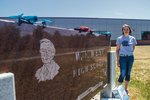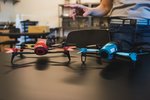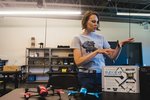





After a local presentation on aviation-based STEM programs for high school students, Chehalis School District plans to implement one at W.F. West.
“We’re just sticking our toe in the water right now, so I don’t know all the hurdles we’ll have to maneuver,” said Chehalis School District Superintendent Ed Rothlin. “There is potential that by spring of next year we could be implementing the program.”
Emily Jordan, who is a science and physics teacher at W.F. West, said she believes the program could definitely be ready by spring 2019. With grant money she applied for last year, Jordan has already purchased three drones — two for students to build and take apart and a third that is commercial grade.
“We’re all about college and career,” Rothlin said. “We’re hearing that there is going to be demand for pilots, including drone pilots, in the future. We are very fortunate to have the airport nearby that could help in some way, possibly with sponsorship or mentoring.”
Brandon Rakes, who is the airport operations coordinator at the Chehalis-Centralia Airport, presented Chehalis School District with the idea a few months ago. Rakes gave a presentation on implementing aviation-based STEM programs to various administrators at high schools in Lewis County.
Chehalis School District is the first to implement the program.
“Brandon Rakes is very gungho about it and willing to help us with anything that we need,” Rothlin said.
Rakes said part of his job is community outreach.
“I think this is a great program,” Rakes said. “I think if children are given a chance to pursue these activities, with aviation being the focus, it will make learning much more engaging. Had I had the opportunity to participate in this type of program, I would have loved it.”
The Aircraft Owners and Pilots Association (AOPA) is currently building a free aviation STEM curriculum for high schools across the country. Rakes said students can use basic math and physics to learn the principles of flight.
“You’re going to use all those same tools, but you’re going to see how they are applied,” Rakes said.
The course is called “Principles of Aviation and Aerospace” and meant for ninth-grade students.
“They would first learn the engineering behind their drone, exactly how they’re built,” Jordan said. “They will also learn about programming, because you have to program remotely to tell the drone what to do. Students will also learn some of requirements. There are quite a few laws around drones — when you can fly them, where you can fly them and how you can fly them. Then they will spend a lot of time practicing flying to increase their skills.”
Jordan plans to attend the AOPA High School Aviation STEM Symposium in Louisville, Kentucky this November. Rothlin said that after Jordan returns, the district will look at its next steps.
In the meantime, Jordan plans to obtain her drone pilot’s license this summer.
“I’m just a self-taught drone flyer so far,” she said.
Jordan said she hopes students leave the class with a license to pilot a drone. With that certification, Jordan said students can work for photography companies, construction crews or the U.S. Forest Service.
“We’re just getting off the ground, so-to-speak, but our hope is students really find this beneficial,” Jordan said.